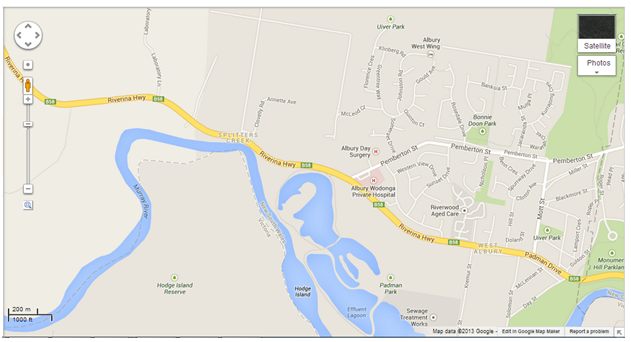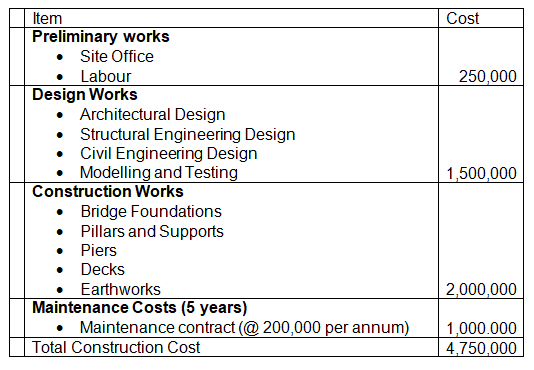Introduction
The Murray River is one of the most important waterways in the entire Australian continent. The river is the lifeline of hundreds of thousands of people who live along its banks. This proposal presents the requirements for constructing a bridge to link the Riverina Highway to the Hodge Island Reserve. The Bridge will open up the Island for tourist activity, and in the process, it will improve the economy of New South Wales (NSW).
The aim of the bridge construction project is to provide tourists with a means of accessing the Hodge Island Reserve for camping and for leisure activities. The project objective is to build a 100-meter bridge to serve as the access route to the Hodge Island reserve.
The rationale for the construction of this bridge is as follows. First, the Hodge Island reserve is currently uninhabited and it serves as a breeding ground for various animals. The island has the potential of employing more than 5000 people directly and indirectly if the NSW government opens it up for tourism.
The Island is an ideal camping ground and can serve a mooring bay for boats. The government will not construct permanent structures on the reserve. It will identify ideal camping spots and make sites for pitching tents. This will ensure that there is minimum disturbance of the environment of the island.

Bridge Design
The Hodge Island Bridge should meet the following design constraints. First, the construction process and the final structure should not lead to major disturbance of the natural environment of the Hodge Island Reserve. The reserve serves as a breeding ground for several species of animals. Extensive damage to their habitat because of bridge construction may lead to permanent loss of breeding grounds for these animals.
Secondly, the bridge should avoid the riverbanks to ensure that the water way is not disturbed. Thirdly, the final design of the bridge and its access road should not disturb traffic on the Riverina Highway.
The bridge should be large enough to accommodate camping trucks, and should be able to support light traffic. The bridge should also have a pedestrian walk way. Since the bridge will lead to a reserve, it will require a barrier to ensure that only authorised traffic enter the Island.
The best bridge design for this project is a cable stayed suspension bridge. This will require only two supports in the waterway, and minimal works on the riverbanks. The proposed design for the is shown in Figure 2 below.

The dimensions of the Proposed Bridge are as follows. The central span will be 100 meters, the deck spans will be 20 meters each. The width of the decks will be 5 meters to accommodate two-way traffic and a pedestrian walk way. The abutment will be 10 meters.
SWOT Analysis
Table 1 below presents the SWOT analysis for the bridge construction project.
Table 1: SWOT Analysis.
Technical Challenges
This project has three main technical issues. These are the design of the bridge, the construction process, and the maintenance requirements in the post construction phase.
The design of the bridge is a technical challenge because of the possibility that the riverbanks may not support the weight of the bridge. This means that extensive civil works may be necessary to ensure that the final structure is stable. The choice of a cable-stayed bridge came from the need to for minimal disturbance of the waterway.
The construction process will also be technically challenging. Any construction process inevitably leads to the accumulation of debris. It is crucial for the contractors to come up with construction processes that will lead to the least accumulation of debris in the construction site. One of the options of achieving this goal is to commission a secondary site for the construction of all steel parts for later assembly.
The third technical challenge associate with the project is the maintenance requirements of a cable-stayed bridge. Cable stayed bridges require regular inspection to ensure that all parts are functioning well. The bridge will have exposure to local humid conditions, as well as fluctuations in the weather patterns. The NSW government will need to appoint a maintenance contractor after the commissioning of the bridge.
Economic Analysis
The main costs associated with this project are as follows.

The Net Present Value
The following calculation gives Net present Value (NPV) of the project.
F = P(1+i)n
Where
F = Future Value
P = Principal
i = Interest rate (10% pa)
n = number of years (5 years)
The NPV for this project is $ 7649922.5
Payback Period
The projected income from this project is estimated at $2,000,000 per year. The Simple Payback Period (SPP) in this case is given by F/I
Where
F = Future Value
I = Income
Therefore,
SPP = F/I
= 7,649,922.5/2,000,000
= 3.8 years
Environmental Impacts
This project will have a varied number of environmental impacts. Table 1 below provides an analysis of these impacts and the mitigation measures applicable for each case.
Table 2: Environmental Impact Assessment.
Risk Analysis
A construction project always has a number of inherent risks. The risk management Matrix below in Table 3 presents the profiles of the risks, their assessment and management options.
Table 3: Risk Management Matrix.
Reference List
FHWA 2011, Technical Manual for Design and Construction of Road Tunnels – Civil Elements. Web.
Karim, S. B. A., Berawi, M. A., Yahya, I. A., Abdul-Rahman, H. & Mohamed, O. 2007, ‘The Integration of Value and Risk Management In Infrastructure Projects: Learning from Others’, Quantity Surveying International Conference., Value Management Centre (VMC), Faculty of the Built Environment, University of Malaya, Kuala Lumpar.
Kerzner, H. 2009, Project Management: A Systems Approach to Planning, Scheduling and Controlling, 10th edn, John Wiley and Sons, Hoboken, NJ.
Lingard, H. & Rowlinson, S. M. 2005, Occupational Health and Safety in Construction Project Management, Taylor & Francis, Oxon.
Othman, A. A. 2005, ‘Value and Risk Management Protocol for Dynamic Brief Development in Construction’, Emirates Journal for Engineering Research, vol 10, no. 2, pp. 23-36.
Tejavibulya, P. & Eiamkanchanalai, S. 2011, ‘The Impacts of Opinion Leaders towards Purchase Decision Engineering under Different Types of Product Involvement’, Systems Engineering Procedia, vol 2, no. 1, pp. 12-22.